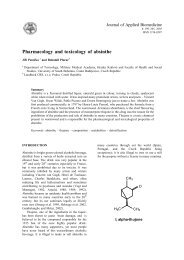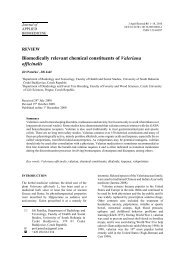Advances in biosensors: principle, architecture and applications
Advances in biosensors: principle, architecture and applications
Advances in biosensors: principle, architecture and applications
You also want an ePaper? Increase the reach of your titles
YUMPU automatically turns print PDFs into web optimized ePapers that Google loves.
1<br />
2<br />
3<br />
4<br />
5<br />
6<br />
7<br />
8<br />
9<br />
10<br />
11<br />
12<br />
13<br />
14<br />
15<br />
16<br />
17<br />
18<br />
19<br />
20<br />
21<br />
22<br />
23<br />
24<br />
25<br />
26<br />
27<br />
28<br />
29<br />
30<br />
31<br />
32<br />
33<br />
need the control the physical <strong>and</strong> chemical parameter of environment. However the major<br />
limitation with cell based biosensor are the stability of the cell, which depends on various<br />
conditions such as the sterilization, lifetime, biocompatibility <strong>and</strong> etc. Another issue that<br />
governs the success of a cell based sensor are depends primarily ion selectivity, <strong>in</strong> which cell<br />
based sensor has poor selectivity of microbial sensor due to the multireceptor behavior of the<br />
<strong>in</strong>tact cells (Belk<strong>in</strong> <strong>and</strong> Gu 2010). Despite these pitfalls the cell based biosensor still favorable<br />
among the researcher due to the advantages over the enzymes based biosensor. The cell based<br />
biosensor are less sensitive to <strong>in</strong>hibition by solutes <strong>and</strong> are more tolerant of suboptimal pH<br />
<strong>and</strong> temperature values than enzyme based biosensor, though they must not exceed the narrow<br />
range <strong>in</strong> case of the cells dy<strong>in</strong>g, a longer lifetime can be expected than with the enzymatic<br />
sensors <strong>and</strong> they are much cheaper because active cells do not need to be isolated (Struss et al.<br />
2010). Literature revealed that, cell based sensor have become an emerg<strong>in</strong>g tools for medical<br />
diagnostics (i.e. such as disease detection), environmental analysis, food quality control,<br />
chemical-pharmaceutical <strong>in</strong>dustry <strong>and</strong> drugs detection (Veiseh et al. 2007, Banerjee <strong>and</strong><br />
Bhunia 2009, Banerjee <strong>and</strong> Bhunia 2010, Wang, T et al. 2010, Melamed et al. 2012, Bohrn et<br />
al. 2012, Liu, Q et al. 2012 ). Similarly, Sh<strong>in</strong>de et al. 2012 conclude that cell based biosensor<br />
is envisioned to be an emerg<strong>in</strong>g frontier <strong>in</strong> the area of nano-diagnotics due to their attractive<br />
characteristic.<br />
Biomimetic sensor<br />
A biomimetic biosensor is an artificial or synthetic sensor that mimics the function of a<br />
natural biosensor. These can <strong>in</strong>clude aptasensors, where aptasensors use aptamers as the<br />
biocomponent (David et al. 2008). Aptamers were reported for the first time <strong>in</strong> the early<br />
1990s where described as artificial nucleic acid lig<strong>and</strong>s. Aptamers were thus chemically<br />
related to nucleic acid probes, but behaved more like antibody <strong>and</strong> show<strong>in</strong>g surpris<strong>in</strong>g<br />
versatility compared to other bio-recognition components (Schneider et al 2010, Brys et al.<br />
2007). Aptamer are synthetic str<strong>and</strong>s of nucleic acid that can be designed to recognize am<strong>in</strong>o<br />
acids, oligosaccharides, peptides, <strong>and</strong> prote<strong>in</strong>s. An aptamer has few advantages over antibody<br />
based biosensor such as high b<strong>in</strong>d<strong>in</strong>g efficiency, avoid<strong>in</strong>g the use of animal (i.e reduced<br />
ethical problem), smaller <strong>and</strong> less complex, <strong>and</strong> etc. However, common challenge fac<strong>in</strong>g<br />
aptasensor is that they <strong>in</strong>herent the properties of nucleic acids such as structural pleomorphic<br />
<strong>and</strong> chemical simplicity which reduced the assay efficiency <strong>and</strong> also <strong>in</strong>crease its production<br />
cost. Subsequently, some effort has been directed towards characterization <strong>and</strong> optimization<br />
9





